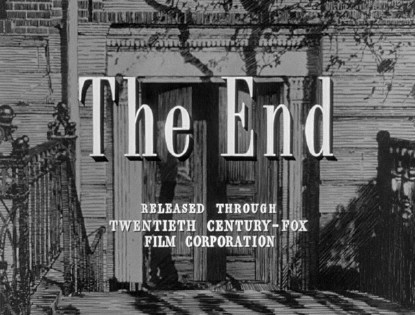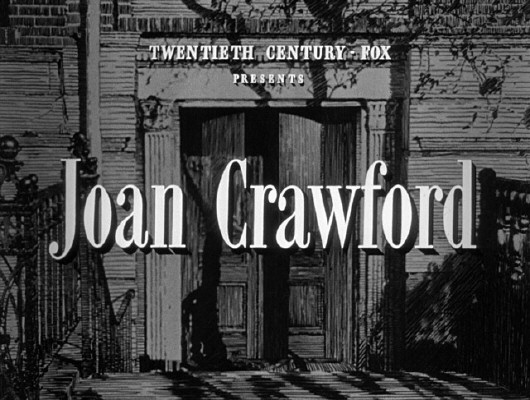
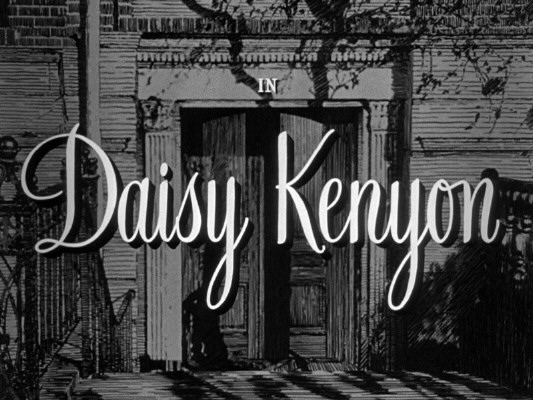
The Best of Everything
Encyclopedia Entry • Films Main
Daisy Kenyon
1947


Critics' Reviews • Our Reviews • Movie Posters • Lobby Cards • Books • Misc. Images
Click here to see photos from the film.
US general release: 12/25/47.
DVD release: 3/11/08. Blu-ray release: 11/15/16. Cast: Joan Crawford (as "Daisy Kenyon"), Dana Andrews, Henry Fonda, Ruth Warrick, Martha Stewart, Peggy Ann Garner, Connie Marshall, Nicholas Joy, Art Baker, Robert Karnes, John Davidson, Victoria Horne, Charles Meredith, Roy Roberts, Griff Barnett. Credits: Based on the 1945 novel by Elizabeth Janeway. Screenplay: David Hertz. Producer/Director: Otto Preminger. Camera: Leon Shamroy. Art Directors: Lyle Wheeler and George Davis. Musical score: David Raksin. Musical director: Alfred Newman. Costumes: Charles LeMaire. Editor: Louis Loeffler.
Plot Summary: Daisy Kenyon stars Joan Crawford as the eponymous heroine, a Manhattan commercial artist. Daisy is torn between two men: a handsome, married attorney (Dana Andrews) and an unmarried Henry Fonda. Deciding to do the "right thing", Daisy marries Fonda, but carries a torch for the dashing Andrews. When the lawyer divorces his wife, he calls upon Daisy and tries to win her back. She is very nearly won over, but her husband isn't about to give up so easily. Both men argue over Daisy, who is so distraught by the experience that she nearly has a fatal automobile accident. In the end, Daisy realizes that she truly loves Fonda, and gives Andrews his walking papers. Daisy Kenyon is given a contemporary slant with a subplot about child abuse (in a Joan Crawford film!); and, in one scene set at New York's Stork Club, several celebrities (Walter Winchell, Leonard Lyons, John Garfield) make unbilled cameo appearances. ~ Hal Erickson, All Movie Guide
Film Notes:
According to a July 1945 Hollywood Reporter (HR) news item, Twentieth Century-Fox purchased the rights to Elizabeth Janeway's novel for $100,000, intending to star Gene Tierney in the title role. By Jan 1946, an HR news item announced that Jennifer Jones was being sought to star in the film. (American Film Institute)
According to publicity materials contained in the film's production files at the AMPAS Library, Joan Crawford wanted to buy the rights to the novel for herself, but Fox purchased them before she had a chance to bid. (American Film Institute)
According to materials in the files on the film at the MPAA/PCA Collections at the AMPAS Library, the Production Code Administration was concerned about the film's "lack of regard for the sanctity of marriage." To ameliorate the situation, the studio was instructed to "avoid any inference of illicit sex" and to emphasize the "wrongness" of "Dan" and "Daisy"'s relationship. The PCA also suggested a reunion between Dan and "Lucile." (American Film Institute)
|
T.M.P. in the New York Times December 25, 1947
Joan Crawford is having man-trouble again in "Daisy Kenyon," which Twentieth Century-Fox presented last night at the Roxy. As the picture opens Miss Crawford is the odd party of that sturdy old triangle and not content with her share of the affections of Dana Andrews who has a wife and two kids over on Park Avenue. Then Henry Fonda comes into her life and proposes marriage, knowing full well that he must for the time being be content as second man in her heart. Now the plot begins to bubble and boil in real earnest and 'ere long we are contemplating a tempestuous romantic quadrangle as Miss Crawford flits from husband to lover and vice versa. "Daisy Kenyon" is "back street" drama with added complications, but it is, notwithstanding the above unadorned outline, somewhat more mature and compelling than the usual run of pictures of this sort. That is, it should be hastily added, up to a point and then the story goes completely to pot. The weakness here is the scenario, for after David Hertz builds up his problem he obviously doesn't know how to resolve it, at least, not with any noticeable ingenuity. Miss Crawford is, of course, an old hand at being an emotionally confused and frustrated woman and she plays the role with easy competence. Henry Fonda, too, is likable but somewhat more sympathetic and passive than a husband in such circumstances has any right to be. As the philandering father, Dana Andrews gives a performance that is full of vitality and technical grace, but it lacks authority. Mr. Andrews, somehow, just doesn't appear to be the type. As the producer-director of "Daisy Kenyon," Otto Preminger keeps the film going at a nice clip and this helps greatly to gloss over the threadbare portions of the narrative, which would be a lot more obvious in the hands of less attractive players.
Otis L. Guernsey, Jr., in the New York Herald Tribune (1947): ...Preminger accomplishes no mean feat in guiding these people in and out among the interweavings of their own complexes, and he does wonders in varying the action of similar scenes. Working with Miss Crawford's iridescence, Fonda's diffidence, and Andrews' aggressiveness, he stages these synthetic involvements as though he believed every minute of them.
Dave Kehr in the New York Times December 30, 2007 (part of review for 16-day Preminger film fest at NYC's Film Forum) ...Of course Preminger was fully aware of the publicity value of trampling taboos and often courted controversy as a way of keeping his name in the papers. Good politics was good business. The lamp never stopped swinging. But as the personality fades, the films remain and seem to grow in stature. Long dismissed as another “women’s picture,” “Daisy Kenyon” now plays as a bristling mass of ambiguity. Joan Crawford, her excesses reined in by the always watchful Preminger, plays a New York career woman — a magazine illustrator with a Greenwich Village studio — who is starting to feel her age. Daisy, no longer content to live with the broken promises of her married lover, a high-powered lawyer (Dana Andrews, in one of his many excellent performances for Preminger, who made him a star with “Laura”), allows herself to be seduced by an emotionally damaged war veteran (Henry Fonda, his dark side on rare display). As the drama unfolds, in a psychological combat zone strung out between the Stork Club in Manhattan and a cabin on Cape Cod, Preminger refuses to favor the point of view of any single character above the others, leaving the viewer with a deep sense of tension and irresolution. In the concluding scene — it is too quick and intangible to be called a climax — Fonda’s character reveals a new aspect to his motivation that casts a very different light on what we have just seen, a device that Preminger would often use in years to come. We think we are watching one film, only to find we’ve been watching another....
Essay by Kevin John ("neumu" site) (2003) |
If you've seen Daisy Kenyon and would like to share your review here, please e-mail me. Include a picture of yourself or avatar to accompany your review, as well as a star-rating (with 5 stars the best) and any of your favorite lines from the film.
|
Rating:
My 2007 DVD of "Daisy" is labeled as a "Fox Film Noir." It's not in any way a "film noir." (Please, modern-day marketing departments, stop!) It's pretty much a domestic melodrama, albeit a realistic one---no one among the major characters is portrayed as either good or bad; all have their flaws.
Joan's "Daisy Kenyon" is a Greenwich Village commercial artist in love with a married lawyer (Dana Andrews), but also mildly pursued by a WWII vet (Henry Fonda). Andrews' lawyer "Dan" is a high-powered, important (and self-important) type, prone to calling everyone, from clients to Daisy to his wife, "Honey Bunch." Daisy's other suitor, Fonda's "Peter," is a self-deprecatory and rather shell-shocked vet, still scarred by his wife's recent death and by his war experiences, but still quite willing to immediately express his love for Daisy after only approximately two dates.
Daisy herself is a bit shell-shocked by both of them. Dan, for obvious reasons (his being married and his history of standing her up for dates), and Peter because he's just immediately declared his love after only two dates! (Daisy on the phone to Dan re Peter: "He's nice but a little unstable.")
There's a mildly interesting initial premise for Daisy Kenyon (a 1947 film, based on a 1945 novel), stated at the beginning of the film with a cabbie noting how the post-WWII NYC population has exploded (fewer cabbies for more people), followed a bit later by Peter's melancholy: "They changed 6th Avenue into something called Avenue of the Americas. It wasn't New York, it wasn't home." A slight nod to the difficulty of post-WWII adjustment, which isn't explored much, other than each of the main characters experiencing a post-War emotional shake-up of some sort.
At one point, the previously brusque, seemingly shallow Dan suddenly takes on a civil rights case for a Japanese man, a US war hero who's lost his property because of discrimination against him. (We see none of this in real action, just learn of it second-hand via conversations and newspaper headlines.) After Dan is beaten both legally and physically, he comes back to Daisy, expecting sympathy, though she's by now made a life with Peter (which doesn't prevent Dan from presenting Peter with divorce papers---albeit unsigned by Daisy!). Dan's life rapidly unravels even further: His wife now wants a divorce herself, and Daisy is forced to testify in court as "the other woman." Despite lack of encouragement, Dan insists on a meeting with Daisy and Peter, which later extends to the Cape Cod cabin that Peter and Daisy have shared after their marriage. Dan's multiple phone-calls drive Daisy nuts, to the point where she must escape the cabin and wreck her car!
What IS the message? That Dan, despite his recent civil rights activism, is still too pushy, too much the "ruthless tycoon" as both Daisy and Peter call him? At the end, after Dan and Peter have met for the third time in front of a cab, Peter says to Daisy: "When it comes to modern combat tactics, you're both babies compared to me." His passivity and gentle understanding have won the day.
Joan, in her early 40s when she made the film, is a bit too old for this particular part. In the novel, "Daisy" is 32 years old, which is perhaps a bit more appropriate for a mistress. That said, Joan's "Daisy" is also a level-headed and self-reliant feminist. She, and the film, make clear several times that her apartment in Greenwich Village (12th Street) is her own, which she has lived in since her early days in NYC (and not the 63rd St. Upper West Side, more genteel, apartment that her lover Dan has offered her). And despite her initial indecision re her two lovers, she's still very honest with both of them, calling both of them out for their shortcomings (Dan = bossy and not faithful; Peter = not mentally stable) multiple times. And lines such as "I'll do my own thinking, thank you" and "I have to fight to stay happy, fight for everything" also are indicative of both her character and her indecision while trying to choose between these two flawed men.
Overall, Daisy Kenyon is a solid domestic drama. I don't think Preminger as director mattered here. Neither did Joan in this role, for that matter. Both were competent but not outstanding. Daisy Kenyon would be a forgotten film without either of these two names attached.
Rating:
Daisy Kenyon
(1947) is the story of a Greenwich
Village commercial artist, played by Joan, who must
choose between two imperfect lovers. One is Dan O’Mara (Dana Andrews), a
successful, sassy lawyer, who also happens to be married and father of
two young girls. It's not obvious that he'll ever leave his wife for
Daisy. The other contender for Joan's affection is Peter Lapham (Henry
Fonda), a quirky widower veteran who came back from WW2 with some
demons. To be honest, I
didn't really like this movie, and am not sure why since many of Joan’s 1930s pictures have a similar set-up in terms of love triangles.
Perhaps the extra 40 minutes in this film made it seem to drag on a
bit too much. Daisy Kenyon also seemed too
convoluted; it reminded me of watching soap operas as a kid with my
grandma---it's tough to figure out what's what without a score card. Moreover,
Joan seemed kind of wishy-washy in making up her mind between the
married lawyer and troubled veteran, moreso than I recall from her
1930s love triangle films. I like my Joanie more decisive! I fully
expected JC to kick Dana to the curb, tell Fonda to shove off, then head
off to her Cape Cod shack for R&R and to find some young boy toy
for a dalliance. On the positive side, the cinematography in Daisy Kenyon
is excellent; it is classic noir in all but subject matter. Joan looks
great photographed at the intersection of light and shadow. This is
perhaps not a surprise given that cinematographer Leon Shamroy was a
4-time Oscar winner. The film is directed by Otto Preminger, whom Joan
gave credit for pulling it all together, but I don’t know much about OP
other than him being Mister Freeze on the campy, mid-60s Batman TV show. My overall rating is one out of five stars for the story and another star for the cinematography. Two stars in total.
Michael Lia (October 2019) Rating: With
Daisy, Miss
Crawford took advantage of her newfound success in her "second" (post-MGM)
career in films; also taking advantage of her recent box-office success was
Daryl Zanuck of 20th Century Fox, who offered the role of Daisy to
Miss Crawford. The book had been a hit and director Otto Preminger was intrigued and looked at the material as
something deep and not a weepy women’s picture; he loved the ambivalence of the character. Although perhaps too old for the part,
Crawford made it
hers, as she usually did. The one thing
that could never die in her stories is Miss Crawford's love triangle (in this
case with Henry Fonda and Dana Andrews) and,
yes, a bit of suffering and confusion. For some
reason, the role of Daisy has polarized Crawford fans, like Johnny Guitar
did or does. Why? The film is unique in certain aspects and after a few
viewings there is no question this is a great 40's Joan Crawford movie!
Is Miss Crawford’s role that much different from any
others? Is Miss
Crawford different for giving an intelligent performance, as many critics
have said? She keeps pace and sets her own terms, just like Daisy does. Daisy is a single independent
career girl with a nice flat
in Greenwich Village and a country house in the woods and a dog. The common bond in
the Elizabeth Janeway novel is the seeking of love and approval,
so therefore there will be denial, struggle, confusion, emotional
determination, and sleepless nights---all good for the box office. Director
Preminger, while for the most part keeping a lid
on the proceedings, does offer some heated exchanges: a
car accident, a courtroom scene, a few slaps and tears. The photography of
cameraman Leon Shamroy (Leave her
to Heaven 1945 and Planet of the Apes 1968) moves with the characters' emotions, and he make the sets
and everybody look great. My favorite thing in movies are the character actors, who usually make a film better. Here, Martha Stewart (murdered in In a Lonely Place 1950) as Daisy's model roommate has some spice; I wish I could have seen more of her and her spunky vibe. Wronged wife Ruth Warrick plays it hysterical and frustrated; the tension and problems she creates and provides keep the movie motivated for the possible "happy ending." Warrick’s father figure, played by Nicholas Joy (Desk Set 1957), a Frenchman with a long list of theatre, is the only person who is astute and flabbergasted at the same time; he tries to keep everyone sane but he has no influence over the raw emotions. Peggy Ann Garner, still riding high from A Tree Grows in Brooklyn, is more grown up and is brave when she has to handle her parents’ divorce suit and entanglements; she becomes the mother for her mother. Even Walter Winchell signed in for a cameo appearance at one of Crawford’s favorite restaurants, The Stork Club. In that scene, you can also get a glimpse of John Garfield and Damon Runyon. Co-star Dana Andrews really put a lot into his role; he should have been nominated for an Oscar, or at least received some recognition in his long career! Henry Fonda---calm, cool, poetic, and with PTSD---does provide us and Miss Crawford with a happy ending! In later years, Preminger couldn’t remember a thing about the movie except that both he and Miss Crawford followed all protocol and created a trouble-free production. Maybe that’s why he couldn’t remember!
Rating:
Though initially overlooked as another soapy vehicle for the actress playing the eponymous heroine, Otto Preminger's Daisy Kenyon is the last in the quartet of consecutive first-rate Joan Crawford pictures during the 40s. In a setting that surely informed the future cosmopolitan romantic troubles of heroines like Carrie Bradshaw, and every episodic rhetorical question she typed into her laptop, Crawford, looking beatific in the lushest hour of her photography in cinema, plays a commercial artist who has been having an affair with a married attorney (Dana Andrews). Daisy seems astute enough to understand the relationship is passionate and ultimately without future, but the lack of reconciliation between those two factors chews away at her. Daisy soon marries the sensitive war veteran Peter (a somewhat darkened Henry Fonda) for the painfully human sake of settling down, but this inspires Dan, whose daughter is subtly implied to be the victim of child abuse at the hands of his wife, to chase her harder. Essentially, the story here is a very simple one: affairs of the heart and their relatable mass of confusion that leads us all to make reckless, and occasionally stupid, decisions. Developing the role that defined so many of her successful vehicles for MGM, Otto Preminger frames Crawford and her two lovers meticulously. Crawford, Fonda and Andrews are actually so natural in their scenes together it could be less acting and more breathing. One gleans the impression that what these characters say to one another are the veiled kind of truths designed to protect the pride. Daisy Kenyon was crafted with the feel of a true film buff. Quietly it pokes fun at melodramatic contrivances and instead offers a mature portrayal of how love's exhortations can roughen up the best of us. It also serves more as a good showcase of Otto Preminger's skills and directorial devices than as a blockbuster geared towards showcasing stars. With Daisy Kenyon, Preminger carefully stages his three main players like chess pieces, luring out subtle and curiously ambiguous performances. Frankly it deserves reassessment.
Rating:
I read the book before I saw the movie. Daisy was such a needy person that I could not imagine Joan Crawford playing a role like that.
The movie showed Daisy to be a stronger person, more in charge of her life. The book was more about the Dana Andrews character. Henry Fonda has a minimal role. The movie was more enjoyable than the book.
Daisy Kenyon is not worth the fuss. And I just don’t mean the film itself. The Daisy that everyone wants to pick is one of Joan’s most wilted women.
From the opening credits on, no one seems sure what this film is all about. Listen to the music … it sounds like we are being set up for a bouncy romantic comedy. But that’s just for starters as we have a lot of plots in Daisy’s garden.
Daisy inhabits an apartment on the most empty street ever to exist in Greenwich Village. Seriously, I think she’s the only inhabitant. Or we might chalk this up to 20th Century Fox shoddiness, which also abounds here. Speaking of shoddy, when we first meet our Daisy, she is wearing the word’s ugliest dress, a sort of Mildred Pierce meets Peter Pan. The collar and turned up sleeves just don’t do it and are ill placed on an artist living in NYC. But then, Daisy gets herself dated up and puts on a replica of this disaster, except the cutesie collar and sleeves seem to be made of lace! And where is she headed in this creation? No less than the ultra-sophisticated Stork Club!
Now would be a good time to wonder: Is Daisy supposed to be some kind of rube? Probably not, despite her fashion sense. She seems to be able to hold her own and, of course, we have Crawford’s impeccable diction. But Crawford cannot seem to find the right notes for Daisy. Too often she seems like she’s just reciting the very talky lines.
Henry Fonda seems like he’s sleepwalking during the whole matter. Apparently he is still recovering from some war horror and we get to watch him endure a nightmare while the Fox orchestra booms.
And Dana Andrews … well, what actor could handle so many pointless subplots? There’s the non-resolved matter of his youngest daughter being physically abused by the mother. And what happened to his crusade to bash racism? And losing all child custody to Ruth Warrick (who should have been banned from all human contact just on the basis of the bad acting she does here)? Andrews’ character is meant to be something of a rogue, but must he call everyone he meets “honeybunch”? There’s also no explanation for why his kids call him by his first name but at this point none is needed.
Everyone talks endlessly about the situation. It winds up with Crawford running through the snow from an incessantly ringing telephone, perhaps scared that yet another pointless conversation will ensue. She rolls her car and is fortunate to walk away with only one forehead curl out of place. Returning to her place to find Andrews and Fonda, playing cards and chummier together than either ever was with her, she orders them both back to New York. I think she might have had the right idea.
|
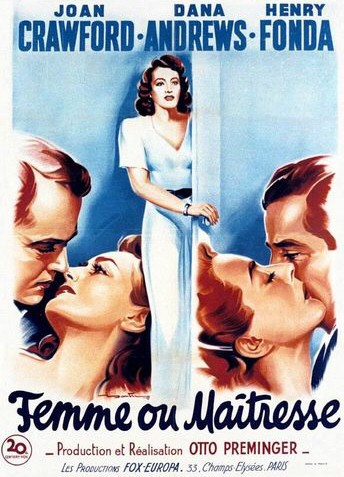
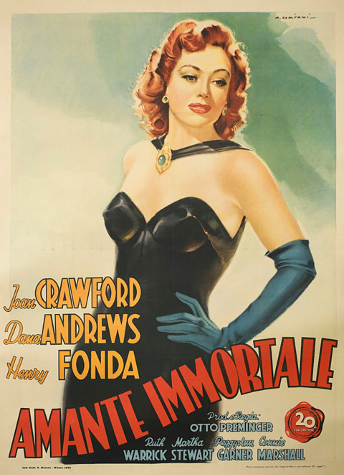
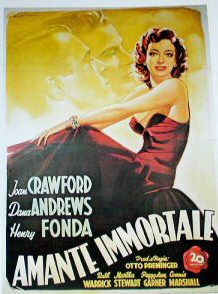
Above: France and Italy. Below: Spain and Sweden.
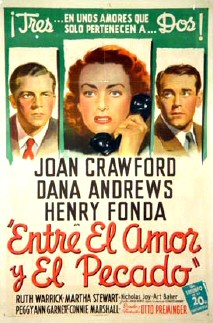
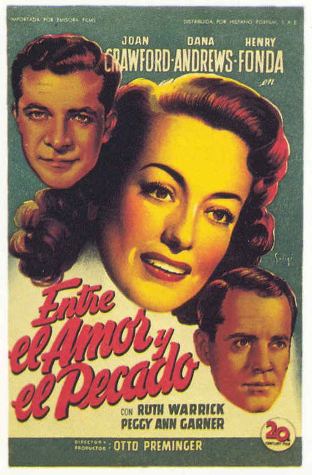
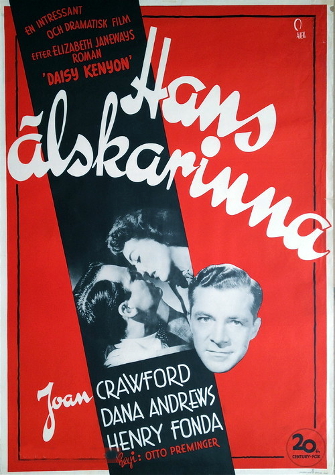
Below: United States.
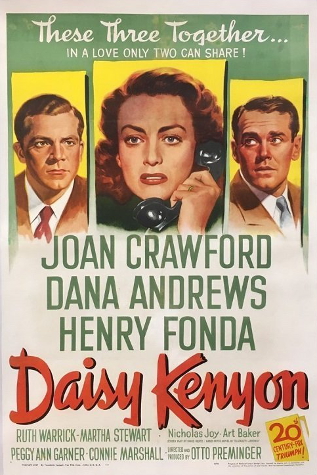
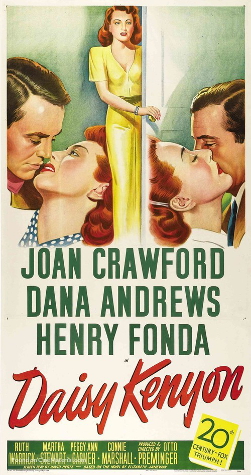
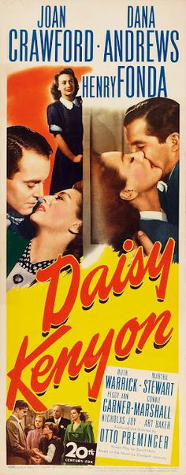
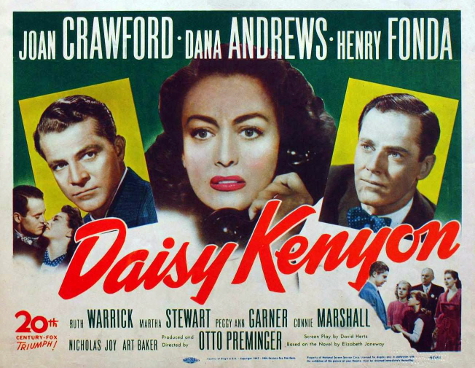

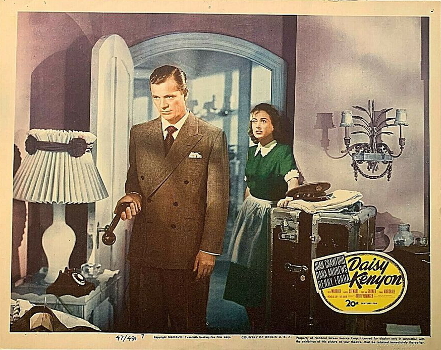
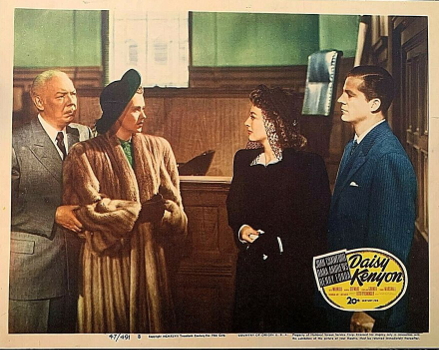

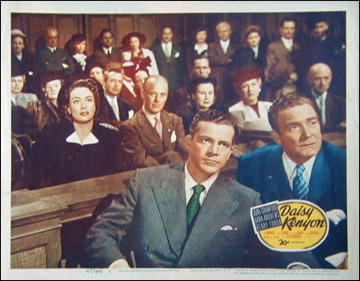
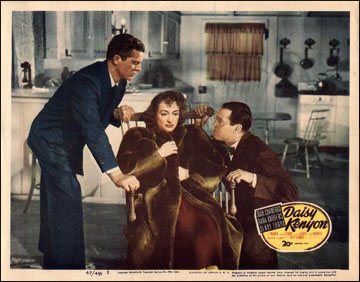
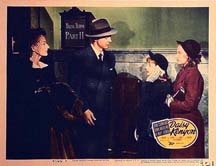
Above: US lobby cards. Below: Mexican lobby card.
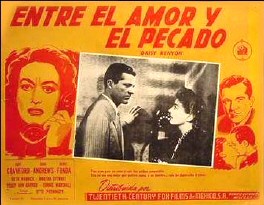
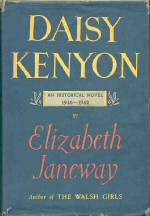
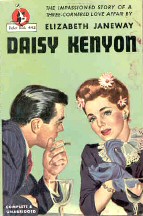
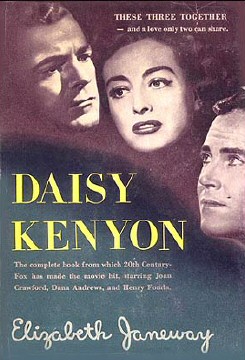
See the Books page for more info.

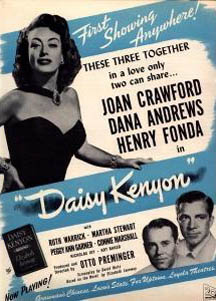
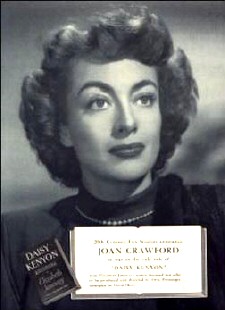
Above: US ads.

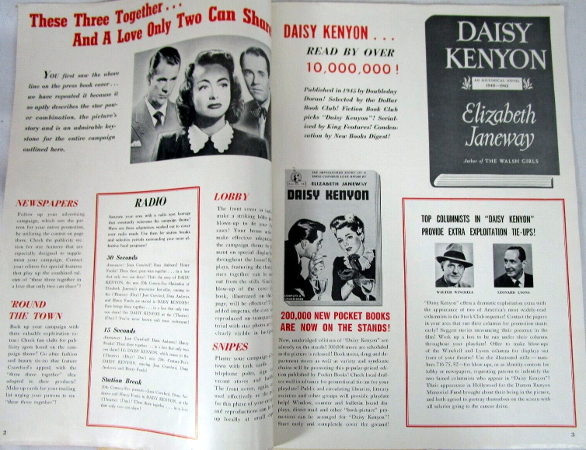

Above: US pressbook.
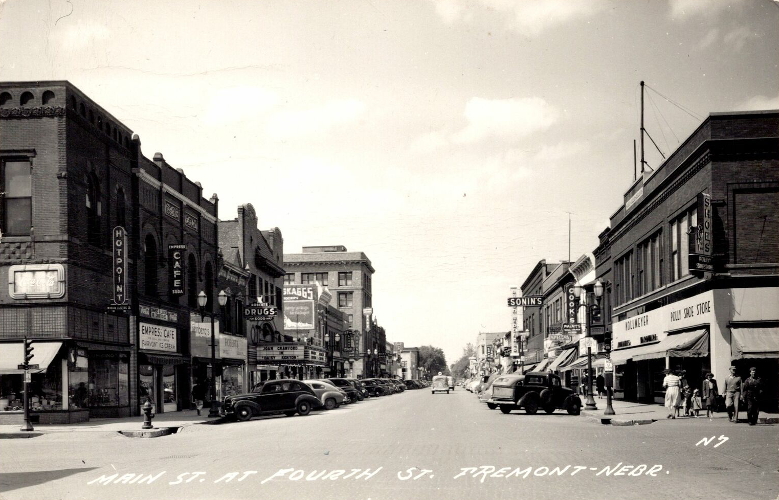
Above: 1947 Daisy marquee in Fremont, Nebraska. (Left side, below "Drugs" and "Skaggs" signs.)
The Best of Everything
